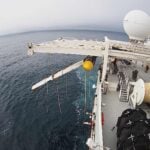When we think of robotic movement, we generally think of something slow and stiff and even unwieldy. Robotics researchers in Switzerland, however, have developed a robotic arm that moves with tremendous fluidity to catch objects that are thrown at it. Unlike other pre-programmed robotic arms that move so slowly because they have to make complex calculations before reacting to changes, this arm essentially thinks for itself.
The researchers imitated the way humans themselves learn, by observing and copying. They taught it to catch, as one might teach a human child to catch. As one of the researchers tosses objects at the robot, another manipulates it manually to make the catch. After several repetitions, the robot learns what to do. As Seungsu Kim explains, this way of transferring information from human to robot is the most novel aspect of their work. “We call this programming by demonstration.”
There is no need to program the robot with specific data about the object’s motion: the robot first uses its system of cameras to observe the object flying towards it a number of times to “build a model” which it can then use to catch the objects in real time, on its own.
In a demonstration, the 1.5-metre-long arm was able to catch various objects of different sizes and shapes—a ball, a hammer, a tennis raquet—with lightning-fast reflexes, timed at less than five-hundredths of a second. As the object approaches, a time of just a few milliseconds, the robot makes all the necessary calculations regarding its trajectory and how to position itself to make the catch.
The work is being done at the Swiss Federal Institute of Technology as part of a Swiss space project called Clean-mE. The program is looking for ways to recover space debris in orbit around the Earth and increasingly dangerous to satellites and other space vehicles.
Besides its possible role as a space junk collector, the arm could be incorporated into machines on Earth to protect humans from falling objects, for example, or even to catch people who were falling.
Their research was published on May 12 in the journal IEEE Transactions on Robotics.


































